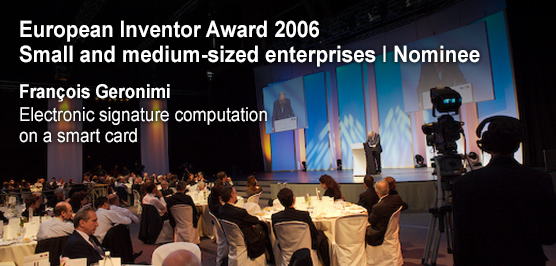François Geronimi
Method of managing an application program stored in a smart card
Smart Gets Smarter
By putting an electronic signature computation on a smart card, more security has been achieved.
Thanks to innovators such as Francois Geronimi, smart cards are all that much smarter – and all that much more secure. While working at French smart card manufacturer Gemplus in the early 1990s (he today holds the title of Research and Development Service centre Director), Geronimi invented a method of managing an application program stored in a smart card (patent granted in 1993), considerably improving on existing smart card security management.
To illustrate how the application could be employed, Geronimi uses the example of the world of pay TV, where a smart card plugged into a special device enables access to certain channels. “In a pay TV world you have encryption that is cracked by hackers. When that happens a new version of the encryption has to be downloaded to the card. With our innovation it is possible to reissue a new version over the air. In other words, to update the card remotely.” If it weren’t for the security feature, in other words, once the card is hacked, access to all channels might be realized, regardless of how many channels the card is programmed to allow access to. Pay TV is just one example, and Geronimi explained that the invention is at the core of security management “It’s the foundation for all types of such security solutions you can imagine in the smart card environment.”
But just how does it work?
It all starts off when an encrypted signature is prepared as a function of a secret code of the microcircuit and certain instructions of the program. The signature is then loaded into a programmable memory of the microcircuit, and the program is loaded into a program memory of the microcircuit. During the execution of the application program, the microprocessor of the microcircuit is made to prepare another encrypted signature, and the encrypted signature prepared is compared with the one recorded. According to the results of this comparison, the program is or is not allowed to proceed.
After finishing his education in engineering in Toulouse, France, Geronimi jumped directly into the smart card field, and two years later, in 1988, he joined Gemplus in its founding year. Gemplus is the holder of the patents associated with Geronimi’s work.
Geronimi explained that it is not possible to quantify the role that his particular invention has had in the overall success of Gemplus and the products the company sells. He said the way to look at it, rather, is as a part of the overall Gemplus smart card offering.
“In order to develop smart cards you need to have all sorts of functionalities on board. For example, advanced memory capabilities, good solutions for managing security, and so on. They are all individual pillars of the overall foundation.”
Though we may not be able to measure individual contributions, what we can take a look at is the overall success of Gemplus. From a company founded by five individuals back in the late 1980s, Gemplus now has more than 6,300 employees around the world and has sold over 5.5 billion smart cards. Revenues in 2005 exceeded 930 million euros. Gemplus’ smart cards are utilized by businesses and governments for such applications as verifying transactions and safeguarding communication. In everyday consumer applications you’ll find Gemplus cards being used as SIM cards in mobile phones, bank cards, loyalty program cards, travel tickets and ID cards.
Geronimi said patent protection played a key role in securing the innovations surrounding his work. “The work, which we undertook in the early 1990s, formed part of a set of complimentary patent applications we filed [for managing security application programs in smart cards],” he explained. “The patent helped to prevent our competitors from doing exactly what we were doing.
“But at the same time, our competitors were doing similar work and coming up with other ways of managing security,” continued Geronimi. “So in the end I guess it all kind of balanced out.”
Not necessarily in terms of market dominance, however: In 2005 Gartner named Gemplus the smart card industry leader, with a 27 percent total market share. It marked the seventh year in a row that Gemplus has secured the title.
Contact
European Inventor Award and Young Inventors Prize queries:
european-inventor@epo.org Subscribe to the European Inventor Award newsletterMedia-related queries:
Contact our Press team#InventorAward #YoungInventors





